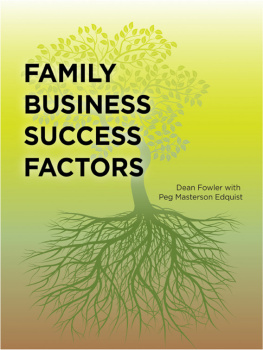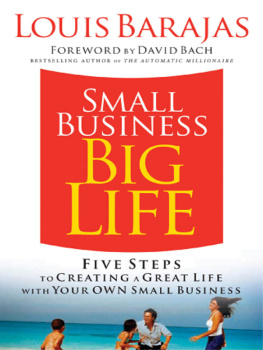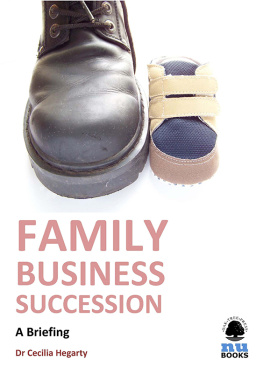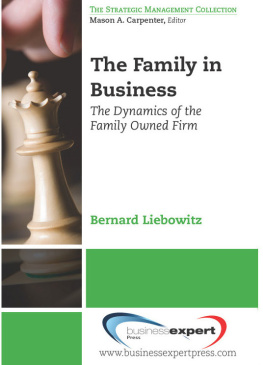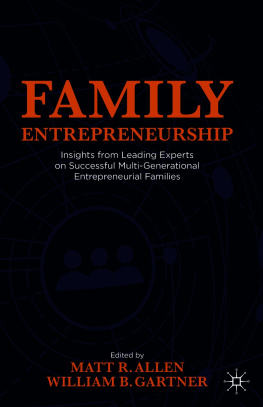Family Business Success Factors
Dean R. Fowler,Ph.D.
With
Peg Masterson Edquist
Smashwords Edition
Copyright 2011
Glengrove Publishing
200 S. Executive Drive,Suite 101
Brookfield, WI 53005
Table of Contents
Transforming Communication:
Enhancing Leadership:
Creating Strategies:
Building Responsible Ownership:
Introduction
Seventy-percent of all family businesstransitions fail. What do successful families do to beat theseodds?
We carried out a research project with over100 successful family businesses, and through our study identifiedtwelve critical success factors for families-in-business. Thetwelve factors fall into four major categories:
Transforming Communication: Family Culture,Career Satisfaction, and Family Relationships
Enhancing Leadership: Successor Development,Successor Competency, and Compensation Standards
Creating Strategies: Business Structure,Non-Family Management and Business Strategy
Building Responsible Ownership: ManagementSuccession, Financial Planning and Tax Planning
This collection of short articles is basedon the stories of the families featured in our full-length book -Love, Power and Money: Family Business Between Generations.We have organized the articles around the four major categoriesoutlined above.
You may also evaluate how well your ownfamily business is doing against these twelve success factors bycompleting our comprehensive Family Business Assessment Tool. Formore information on our Assessment Process, please link tohttp://www.deanfowler.com/services/assessment-tools/
CareerSatisfaction
Career satisfaction should never be takenfor granted as a key to making a successful family businessfunction. Being next in line to inherit the family business doesnot mean the successor is a good fit for the business, orconversely, that the business is a good fit for the successor.
The case of the Mathison family illustrateshow this dilemma can cause problems for the successor. JohnMathison owned a manufacturing company that had developed aspecialized, highly engineered mechanical device used throughoutthe machine tool industry. John patented his invention anddeveloped a successful niche market for himself and his company,which generated revenues of just under $100 million a year. Hisson, Todd, began to work in the company as soon as he completedcollege. Todd was a talented electronics engineer who saw ways toexpand the company's business, building on the accomplishments ofhis father. However, Todd did not really enjoy running theoperations side of the business. Todd's entrepreneurial nature kepthim focused on new business. Over dinner on a business trip, thefather and son recognized and felt the respect and trust each hadfor the other. Todd pledged that if he were chosen to run thecompany, his mother and sister would share fully in the financialrewards.
Three days after their trip, John Mathisonsuffered a massive coronary and died. Unfortunately, the father haddelayed the preparation of a new estate plan. When John died, theold plan went into effect, splitting ownership of the businessthree ways: To his son, to his daughter and to his wife. AlthoughTodd and his father had agreed in principle on a plan regarding thestock and the eventual transfer of total ownership and control ofthe company to Todd, their plan was never legally implemented. Toddfelt that he needed to take care of his mother and sister, yet helacked the real desire to run business operations. This is a caseof career satisfaction and family responsibility at odds with eachother. Career satisfaction allows an individual to express his orher own interests and talents, but in family businesses, youngadults are often torn between their sense of loyalty to the family,opportunity for security and income through the business, and thecompeting needs of their own individual interests and talents whichmay guide them in directions distinct from the opportunitiesprovided in the family business. Ultimately, Todd wisely chose tobring in an outsider. He hired a search firm to find a qualifiedcompany president to run the day-to-day functions, and recruitersfound a respected executive from within the industry. Todd hiredthis executive, who became president, while Todd became chiefexecutive officer. I felt like I was putting an enormous puzzletogether, Todd said. With someone to run the existing business, Icould focus on the opportunities that gave me the most personalcareer satisfaction."
SecondGeneration: Blessing or Curse
One of our most memorable clients was ayoung man who was the oldest son of a second-generation familybusiness owner but referred to himself as a victim of the"marshmallow effect." What's that?
This client wrote an article on the subjectand allowed us to reprint it for others. He calls his familybusiness both a blessing and a curse. He explained that although itis always there as a safety net, it can also drain the motivation aperson needs to achieve their ambitions.
Now, about the marshmallow effect.
"It occurs when young heirs, like me, allowthemselves to be absorbed by a sweet, comfortable, and ultimatelysoft option that is extremely easy to get into, but almostimpossible to escape from," he said.
While this may seem a lot better than mostemployment options in our current economy, this client is smart tobe aware of this potentially dangerous lure. The marshmallow effectcan have serious consequences in most cases because someone whodrifts into a career will likely never experience professionalsatisfaction. He or she is also likely to suffer from a lack ofself-confidence, never sure whether his position is a product ofeffort or name. This can lead to low morale and family conflict,because the person often blames or resents other relatives or thebusiness for his lack of happiness.
The business suffers, too, becauseuninspired employees do not achieve results. Although this youngfamily business member has no desire to join the family business,he said it always beckons.
"Several times in my youth I was tempted todrop everything and allow myself to be 'marshmallowed' -- when themoney became tight, or the going got tough," he said.
The saving grace for him came in the form ofa "five-year rule" imposed by the company that states no familymember may enter the business without at least five years'experience elsewhere. It is designed so that family members whocome into the business do so by choice, and with skills andexperience that will benefit the organization. It also preventsoffspring from drifting into the business without having firstattempted to develop themselves and their potential.
"It forced me to motivate myself to workharder. And if I do someday enter the business, I'll know that itwill be my work that will have gotten me there."
SiblingRivalry
Sibling rivalry is a term most oftenassociated with children; young brothers and sisters jealouslystruggle for their parents' attention. Rivalry may continue intoadulthood, and as such it can devastate your family and undermineyour business. This rivalry between siblings actively involved in afamily-owned business takes two different forms: emotional andstrategic. To find solutions to resolve conflicts among brothersand sisters in family businesses, one must first determine if therivalry is emotional or strategic, or some combination of both.
The siblings in the Jones family are atypical example of emotional rivalry. The two sons were in aconstant battle for approval by their entrepreneurial father. Thesmall manufacturing business was a success, and both brothers were,in fact, technically competent. They had been given increasedmanagement responsibilities at their company through the years, andfinally father named each brother to the position of generalmanager of separate operating divisions. These operating divisionsdepended upon one another for the production of parts, which werethen assembled into a finished product to be shipped to thecustomers. Because they were in an emotional rivalry for approvalfrom their father, the brothers competed against one another todemonstrate who was best, hoping to gain their father's blessing,rather than cooperating with one another to achieve success for thebusiness as a whole.

